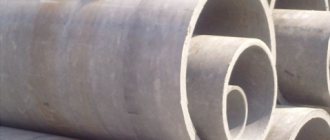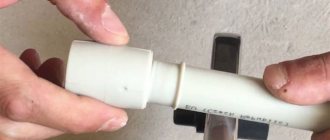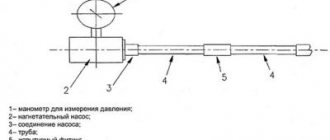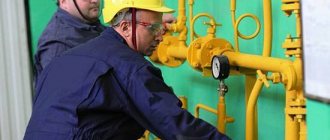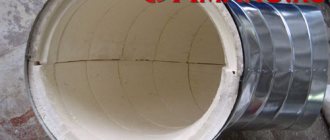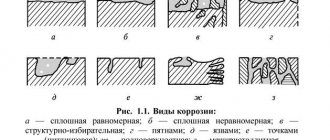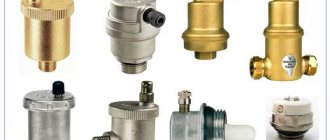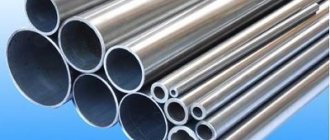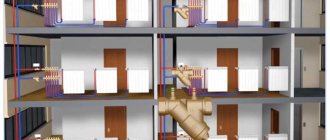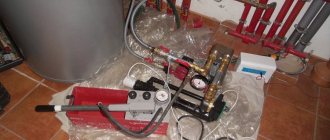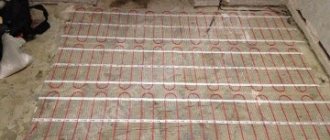Purpose of devices
Any heating main constantly operates under serious load. The walls of the pipeline can withstand high pressure. Temperature changes occur regularly. And besides, the system receives strong water hammer at different intervals.
All this causes the material from which the heating network is made to either shrink or, on the contrary, expand. Such movements inevitably lead to deformations and irreversible overloads. And in the end, the whole system quickly fails.
Special protective measures can help avoid regular accidents and extend the operational life of the heating main. To increase network service, elements such as compensators for heating pipelines are installed. These parts, due to their elasticity, are able to significantly smooth out critical loads in the system.
Flange compensator Source climatik.su
The importance of such protective elements is undeniable. They significantly dampen the vibration that occurs in the system due to the operation of the pumps. You may not even feel it tactilely, but it is there. And the greatest danger arises when the vibration transmitted by the pump coincides with the vibrations of the pipeline itself. Such resonance increases the pulsation frequency several times, and the destructive consequences occur much faster.
The second important point is balancing the dimensions of the pipeline itself. Materials shorten or lengthen under the constant influence of different temperatures experienced by the fluid passing through the pipes. Such changes most affect welded joints. The coupling joints suffer no less. Such loads can lead to rapid destruction of these units.
At the moment, the installation of protective elements in the heating main is a mandatory measure to ensure the reliable operation of the heating system. This measure significantly increases the periods between preventive repairs. In general, it creates favorable conditions for long-term operation of all equipment.
Pipeline with U-shaped expansion joints Source vse42.ru
See also: Catalog of companies that specialize in water supply, sewerage and related work
Basic requirements for the installation of bellows expansion joints
General requirements for the installation of bellows expansion joints and bellows expansion devices
Bellows expansion joints and bellows expansion devices (hereinafter referred to as expansion joints) must be installed in the temperature range specified for construction and installation work.
At outdoor temperatures below minus 15 ºС, moving bellows compensation devices with thermal insulation made of polyurethane foam in a polyethylene shell applied to the nozzles in the open air is not recommended. Installation and welding work at outside temperatures below minus 10 ºС must be carried out in special cabins in which the air temperature must be maintained above minus 10 ºС. Thermal insulation of pipeline joints with polyurethane foam or polyurethane foam thermal insulation with thermally waterproofed bellows compensation devices at outside air temperatures below 0 ºС is not allowed. Compensators should be delivered to the installation site in the manufacturer's packaging. At construction sites, bellows expansion joints should be laid on sand beds that are free of stones and hard sharp objects. To protect thermally waterproofed bellows compensation devices from direct exposure to precipitation and ultraviolet radiation, it is recommended to cover them with an awning before the start of installation work. During installation, measures must be taken to protect the expansion joints of the device from flooding with groundwater.
The installation of expansion joints must be carried out by a specialized organization that has the technical means to perform these types of work with high quality, and also has the right to carry them out. Installation must be carried out according to the documentation of the designer of the pipeline system or mechanisms. The installation of expansion joints should be carried out in the places specified in the design documentation.
Before starting work on the installation of compensators, it is necessary to mount and secure the pipelines on fixed and guide supports. Before starting installation, it is necessary to remove the expansion joints from their packaging, make sure by external inspection that there is no damage, and check the compliance of the installed expansion joints with the working design documentation. Mechanically remove the protective easily removable coating from the connecting surfaces of the compensators, clean and degrease the surfaces. Make sure that the ends of the connecting pipes are properly prepared. For compensators whose installation requires preliminary deformation, remove technological limiters (spacers, bolts, devices).
If compensators with internal guide pipes are used, they should be installed on pipelines so that the direction of the arrow on the compensator body coincides with the direction of movement of the conductive medium.
Permissible mounting deformations of expansion joints must be within the limits of displacement and parallelism of connecting surfaces of pipeline connections established by the current regulatory documentation of the object of application. The total value of installation and operational deformations should not exceed the values specified in the passport.
During installation, take into account that the installed expansion joints must be removed from structures, equipment and pipelines at a distance exceeding the permissible deformation of the expansion joints.
Compensators should not experience loads from the pipeline not provided for by the design during bending, torsion, vibration and distortions of the pipeline. It is not allowed to load expansion joints with the weight of connected sections of pipes, fittings and mechanisms. If necessary, special supports or other devices must be used to eliminate extra-design loads on the expansion joints.
When flanging expansion joints to a pipeline or equipment, it is necessary to ensure uniform tightening of the fasteners.
Compensators, in which the connecting fittings are made in the form of welding pipes, are connected to the pipeline by a welded joint using a butt seam. Welded connections are made in accordance with GOST 16037-80 “Welded connections of steel pipelines. Basic types, structural elements and dimensions" or GOST 14771-76 "Gas-shielded arc welding. Welded connections. Basic types, structural elements and dimensions." The type of seam is indicated in the pipeline design.
Before installation, prepare the pipeline section for inserting the compensator: clean the pipeline from dirt, sand, scale and other contaminants.
Welding of expansion joints is carried out in accordance with departmental technical documentation, approved in the prescribed manner, taking into account the requirements of RD 153-34.1-003-01 “Welding, heat treatment and control of pipe systems of boilers and pipelines during installation and repair of power equipment.” The welding technology used must ensure equal strength of the welded connection of the compensator with the pipeline element in the absence of adverse effects on the structure and mechanical properties of the metal of the connected products.
When performing welding work, it is necessary to ensure protection of the surfaces of the expansion joint bellows and their insulation from splashes of molten metal, weld beads and scale.
After installing the expansion joints, technological restrictions (spacers, bolts, devices) from the expansion joints (except for expansion joints, during the installation of which their preliminary deformation is provided) must be removed and hydraulic tests of the connection of the expansion joint with the pipeline or equipment must be carried out by test pressure for strength and tightness. It is not allowed to load expansion joints with test pressure for no more than 24 hours, and also to carry out hydraulic tests of pipelines with installed expansion joints until all work on the manufacture and installation of fixed and guide supports and the pipeline is secured to them is completed. For expansion joints connected to a pipeline by a welded joint, 100% inspection of welds by non-destructive methods is allowed.
When laying without channels, it is not allowed to carry out hydraulic tests of a pipeline with installed expansion joints that is not covered with soil (to control the expansion joints and subsequent work on insulating joints, pits must be left at this time). It is not allowed to supply hot coolant into a pipeline that is not covered with soil.
After completion of hydraulic tests (inspection of welds), surfaces of expansion joints that have damaged paint, including after removal of fixing elements and mounting devices, should be cleaned and painted to prevent corrosive wear. Coatings must comply with operating conditions and meet the requirements of regulatory documentation approved in the prescribed manner.
Types of compensators
The choice of a protective element must be approached responsibly even at the preparation stages. Since heating networks are installed from different materials, different types of pipeline expansion joints are manufactured for them. In this case, you need to calculate the possible overload, and only then select an element with suitable parameters.
Omental
This type of fuse was one of the first to be used. And although the method is quite old, it continues to be used to this day. Because it guarantees smoothing out the increase in the dimensions of parts due to high temperature throughout the entire system, no matter how long it is. But such a compensator has a lot of disadvantages.
Disadvantages of stuffing box elements:
- Constant monitoring is required to detect leaks.
- They do not tolerate angular stresses well.
- Repairs are expensive and difficult to carry out.
- Not able to withstand chemical aggression.
Stuffing box compensator Source gryazeviky.ru
But even with such an abundance of shortcomings, stuffing box elements are positioned better than bellows pipeline compensators. And the whole point is that the smoothing ability of the former increases in proportion to the increase in network volume. The longer the pipeline is installed, the more reliable it works.
The steel structure includes two shells with different volumes. The smaller one is inserted into the larger one, and the connection is sealed with a special gasket. The stuffing box compensator can withstand pressure up to 2.5 MPa and an increase in ambient temperature up to +300 °C.
The inner tube can move inside the larger element, compensating for elongation and compression. And leaks are prevented thanks to a reliable seal. But due to the need to regularly tighten the hydraulic axle, the heating network must have an inspection well above each one.
Rubber
These fuses are the next most popular in use. Because they are universal and suitable for both steel structures and their polypropylene counterparts. Their fundamental difference is that the working element is a rubber insert.
Rubber expansion joint Source stblizko.ru
The advantages of rubber expansion joints include:
- Long service life (at least 20 years). Moreover, no repairs or maintenance are required throughout the entire period.
- More reliable resistance to cycle displacements relative to the original installation.
- Resistance to short-term axial deformations (tension and compression).
- The ability to wait out a vacuum.
- Resistance to aggressive chemical environments.
The working rubber element is placed between two steel flanges. The fuse also withstands system pressure up to 2.5 MPa. But the temperature increase should not exceed +200 °C. The protection began to be used to replace the U-shaped compensator, which was popular earlier, but did not always cope with the assigned tasks.
Which option is better to install on polypropylene?
The range of devices offered by manufacturers allows you to select the right type for polypropylene pipelines for any purpose and installation method. Depending on the conditions of use, the following are used:
- Axial bellows-type expansion joints designed for use in heating and hot water supply systems. They are connected to pipes using couplings. The bellows is made of thin stainless steel and can withstand pressure up to 16 atmospheres at a temperature of 115 ⁰C.
- Shear devices with two corrugations - compensate for thermal expansion in 2 directions simultaneously.
- Rotary - used in places where the pipeline line changes by 90⁰.
- Universal varieties - used in small areas with branches. Compensate for transverse, angular, axial displacements. They are installed where it is not possible to use other types.
- Flanged expansion joints made of soft materials are designed to mitigate water hammer. They will smooth out minor flaws made during the pipe laying process. They are easy to install and replace since no welding is required during installation.
- Compensators in the form of coils.
- Loop-shaped ones are the simplest. They are easy to make yourself from a piece of polypropylene pipe. Despite the simplicity of the design, they successfully perform the same functions as their factory counterparts, but take up more space.
Video description
The following video will tell you what types of heating compensators there are:
Other types of devices
If the heating or water supply line is laid in zigzags or has curved sections, then radial compensation options are used. In this case, natural smoothing occurs due to the displacement in the area of turns in the route.
The same functions are performed by U-shaped compensators. And these are not separate elements. It’s just that the highway has U-shaped waste at regular intervals. They allow you to smooth out temperature expansions. But for such a system to work, one condition must be met.
All pipeline turns are placed in a special box. Its width should be sufficient to provide enough space to extend the line when heated. To do this, make preliminary calculations of future loads, and then arrange a place for turning.
A polypropylene compensator operates on a similar principle. This is a piece of ordinary plastic pipe twisted into a ring. Such an element is not buried in the ground. It is usually installed indoors. It creates mobility in the system and this compensates for expansion or contraction.
When are compensators needed?
Since polypropylene has a high coefficient of thermal expansion, pipes made from it must be equipped with protective devices. Compensators are installed:
- on the water supply;
- when installing heated floors;
- on the sewer;
- in heating and hot water supply systems.
The devices are installed on horizontal and vertical pipes in residential buildings, industrial and administrative buildings. Their use provides:
- long trouble-free service life of the pipeline;
- turbulence damping;
- stability of pressure in pipes during pressure surges;
- protection against water hammer;
- no distortion due to thermal expansion.
Briefly about the main thing
Before you equip the heating line, you need to take care of its protection. Working under high pressure and periodically changing temperatures leads to regular compression and expansion of the system. This is fraught with early failure of the pipeline connecting units.
There are quite a lot of special compensators that can smooth out both vibrations in pipes from equipment operation and expansion of the pipeline as the temperature rises. But before installing a protective fuse, it is necessary to calculate the loads on the heating network. Based on the data obtained, you should select a compensator of the desired design and from a suitable material. This will ensure reliability in the future operation of the entire system.
Ratings 0
